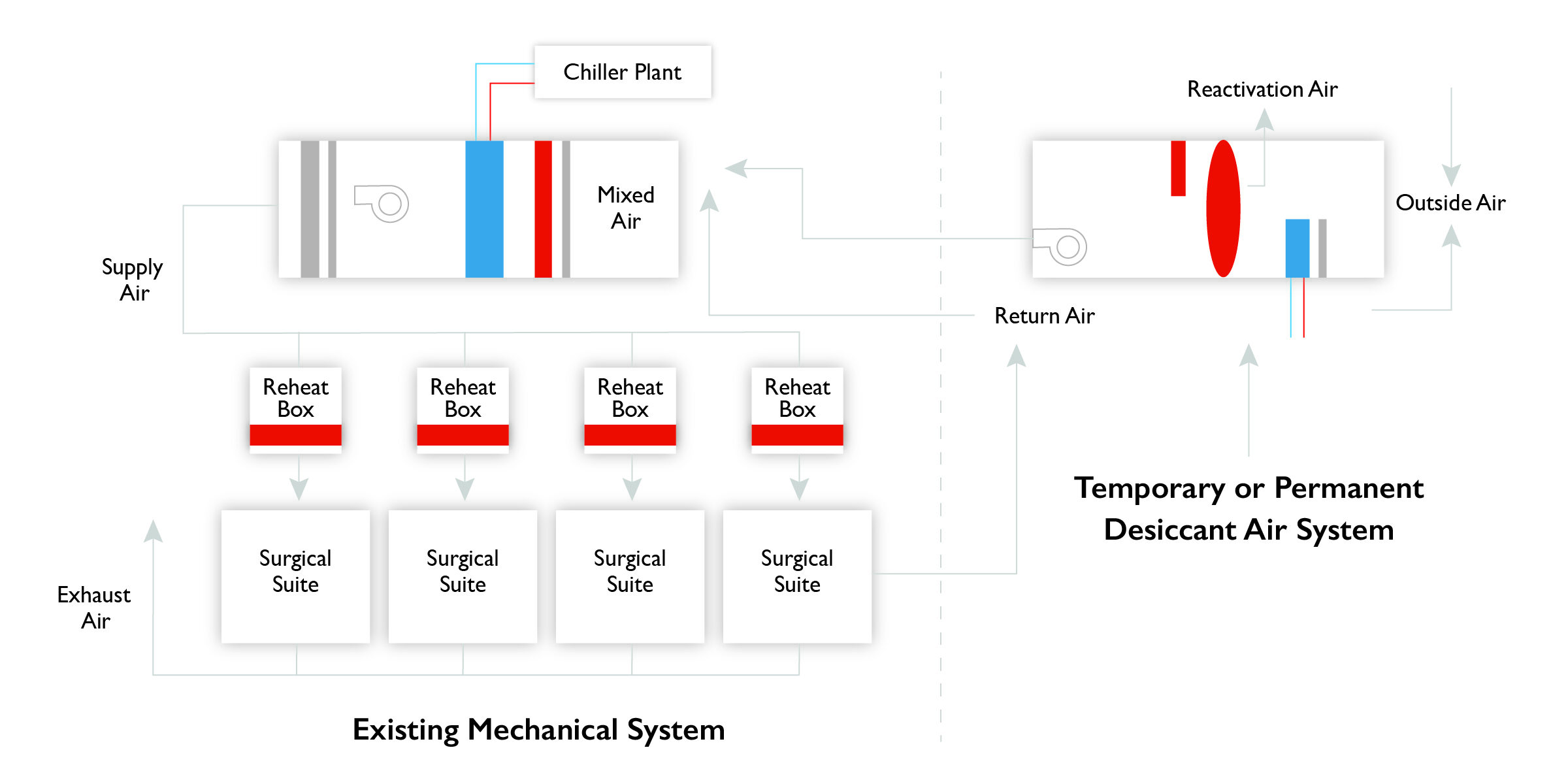Operating suites are one of the most critical areas of hospital operations. ASHRAE Standard 170 ventilation of healthcare facilities requires RH levels below 60%. Both the National Fire Protection Association (NFPA) and the Facility Guidelines Institute refer to Standard 170. In addition, the Joint Commission and Centers for Medicare and Medicaid Services enforce these limits and require continuous monitoring of operating room temperature and humidity to ensure constant compliance. Aside from these regulatory requirements, there are numerous additional reasons to maintain RH below 60%:
- Fewer patient complications while under anesthesia
- Decreased risk of wound infections
- Blood vessels and tissues swell less, decreasing the risk of bleeding and post-operative pain
- Surgical instruments stay dryer
- Reduced surface mold and mildew growth
- Ensures proper operation of delicate electronic equipment
- Self-life and product integrity of sterile supplies are better protected, such as sensitive EKG electrodes
Keeping operating room humidity below 60% RH becomes more difficult as the surgical staff request conditions below the “typical” design temperature of 68°F. Some surgical teams are requesting temperatures as low as 60-64°F. The reasons for these low temperatures can vary; for orthopedic procedures, the premature setting of the adhesives being utilized can be a concern. In other cases, lower temperatures are requested to ensure the surgical team does not overheat while performing lengthy procedures under lights and dressed in multiple layers of gowning.
Conventional Mechanical Systems Can Perform Poorly
For conventional mechanical systems that utilize sub-cool, reheat methods to obtain humidity control, this can be a serious problem resulting in poorer patient outcomes and increased downtime. Simply put, the lower the desired space temperature, the more difficult it is for these types of systems to achieve the proper humidity level.
For example, operating room conditions of 68°F / 55% RH results in a dewpoint of 51°F. Factoring in the internal latent load of the space, leaving air conditions from the air handling unit might be as low as 46-48°F dewpoint. This requires chilled water conditions of 41-43°F.
Operating Room conditions of 64°F / 55% RH results in a dewpoint of 47°F. Factoring in the internal latent load of the space, leaving air conditions from the air handling unit might be as low as 42-44°F dewpoint. This requires chilled water conditions of 37-39°F.
These low chilled water temperatures are not always available in a facility and would likely require large expensive infrastructure upgrades. The use of desiccant dehumidification systems eliminates the need for specialty low-temperature chilled water systems, and humidity levels can be achieved regardless of the space temperatures requested.
Desiccant Systems Provide a Fast, Simple Solution
A hospital system in New York State was concerned about meeting proper quantity of outdoor air during peak summertime conditions while simultaneously maintaining precise temperature and humidity control with their aging infrastructure.
Their existing chilled water was only available to provide 48°F chilled water and they could not meet the 60% RH requirements. The dewpoints off the chilled water coils were 54°F, which was not low enough once the internal room latent load was factored in. They required a solution for the upcoming cooling season, that was simple, cost effective, and could be implemented within a 2-week time frame.
Using an “add on” desiccant-based dehumidification unit, we provided a rental system for the summer. The unit was installed on the roof with temporary ducting connected to the existing OA intake louvers that served the existing OR air handling unit. This enabled handling of all the outside air latent load, while “sub-drying” the air to handle the internal latent load as well. The existing air handling unit was then just a sensible cooling device. The only utility connections required to the desiccant-based system was electricity. The unit was installed and operational in two weeks.

If you need further information on temporary or permanent desiccant dehumidification systems to help maintain operating room humidity, please call us with your questions at 203-261-8100 or use our contact form.

















